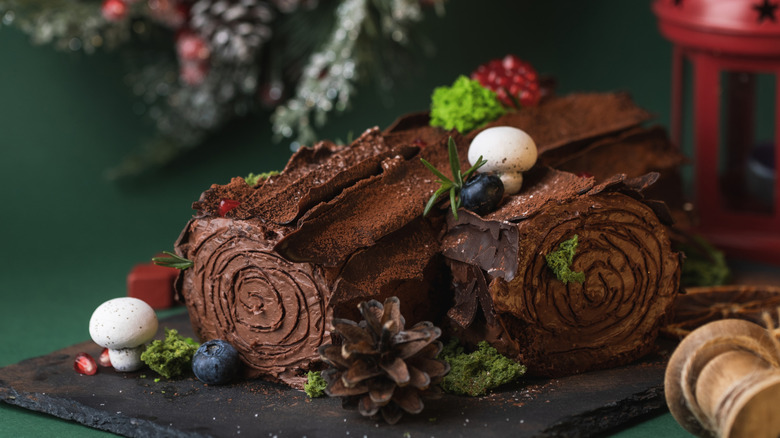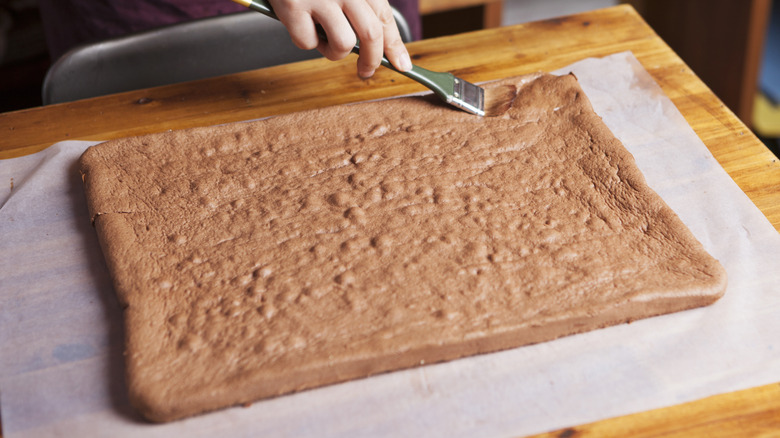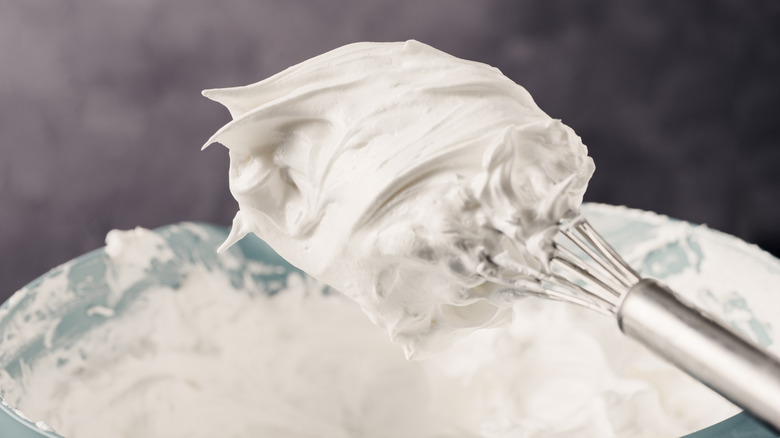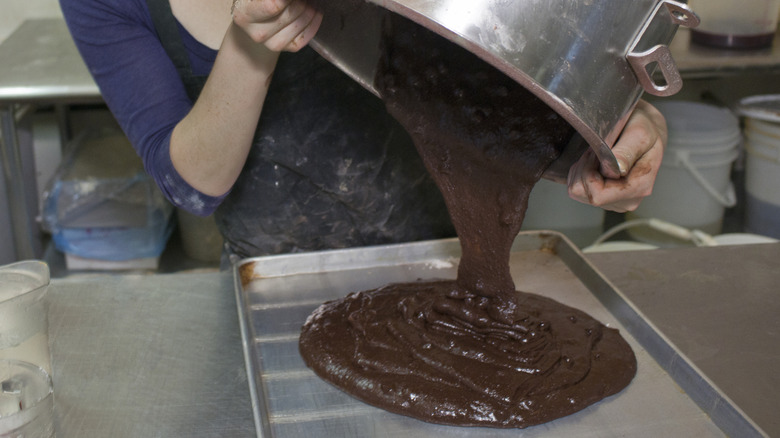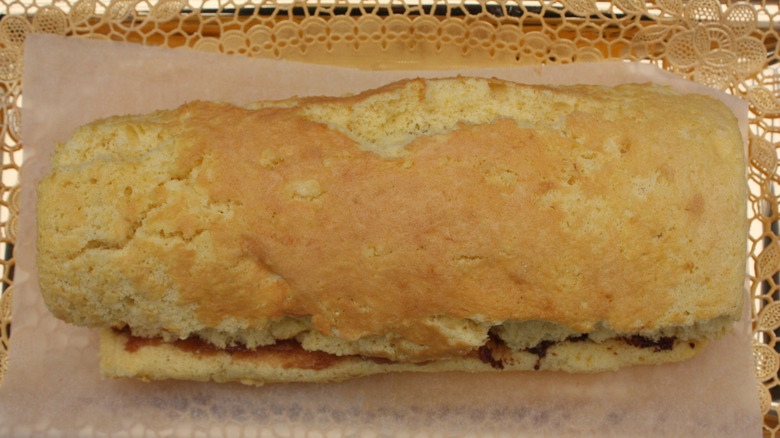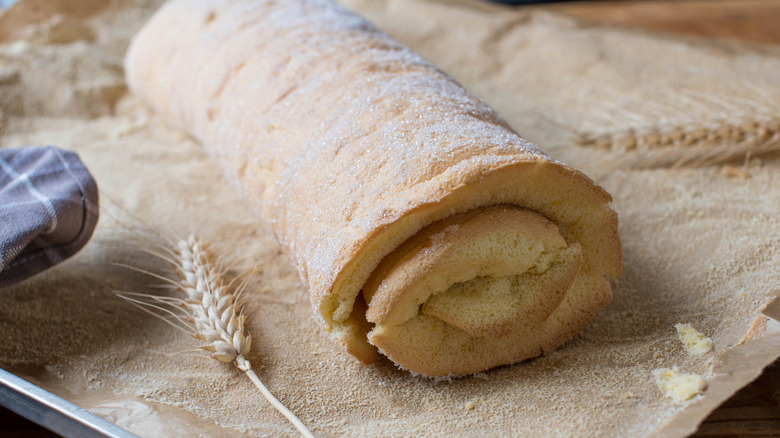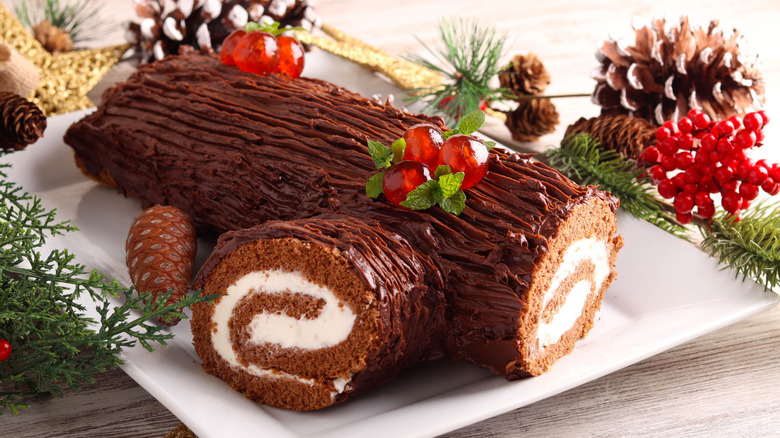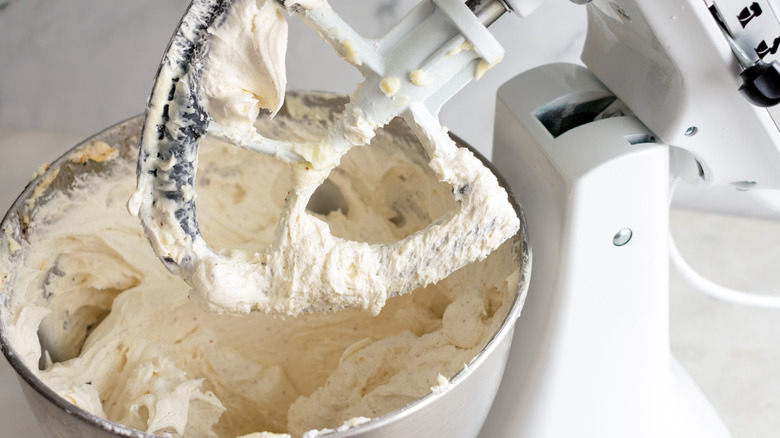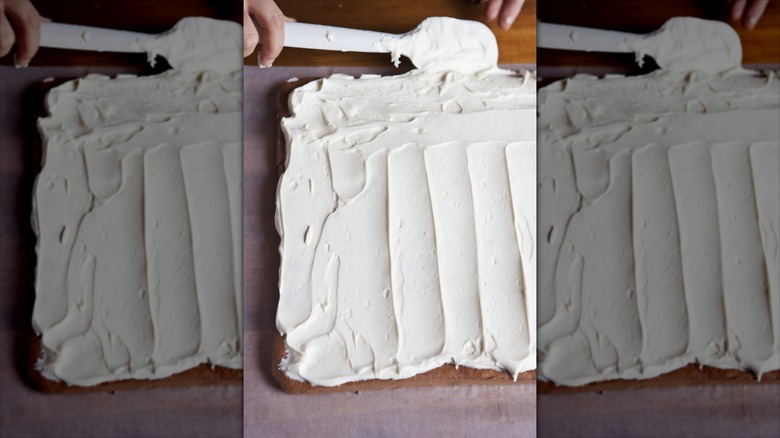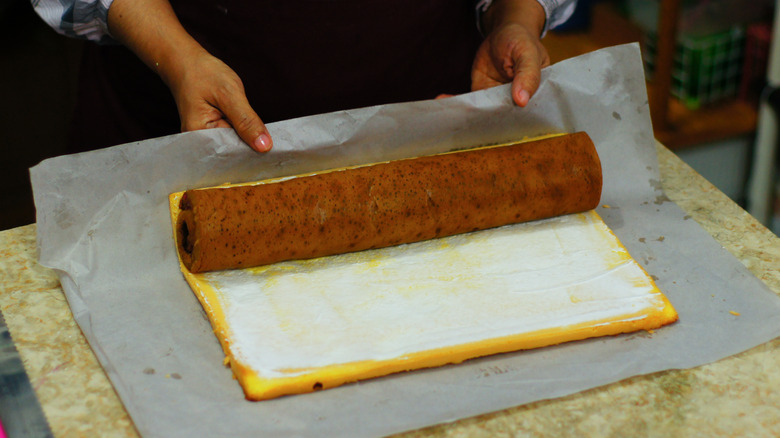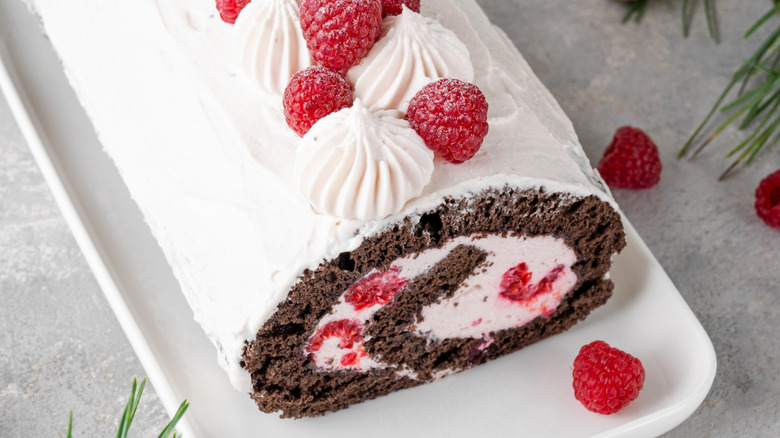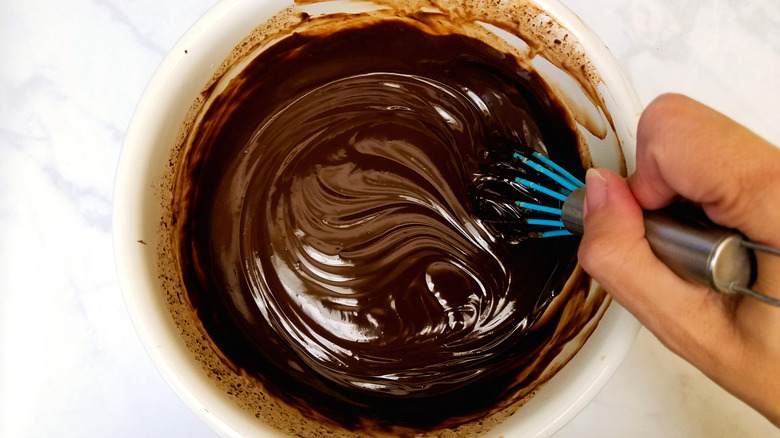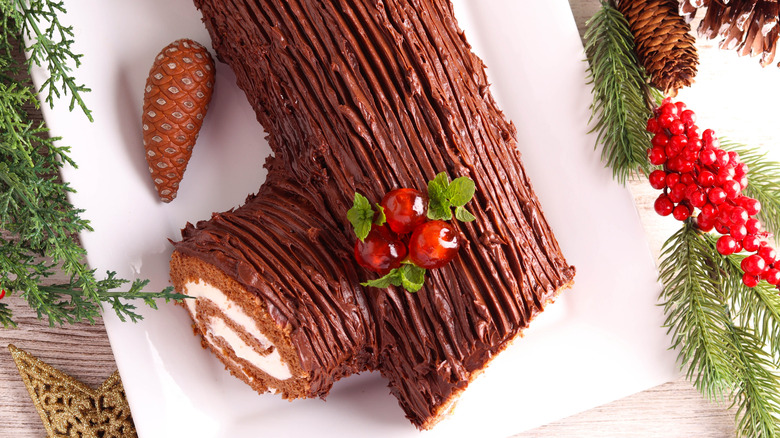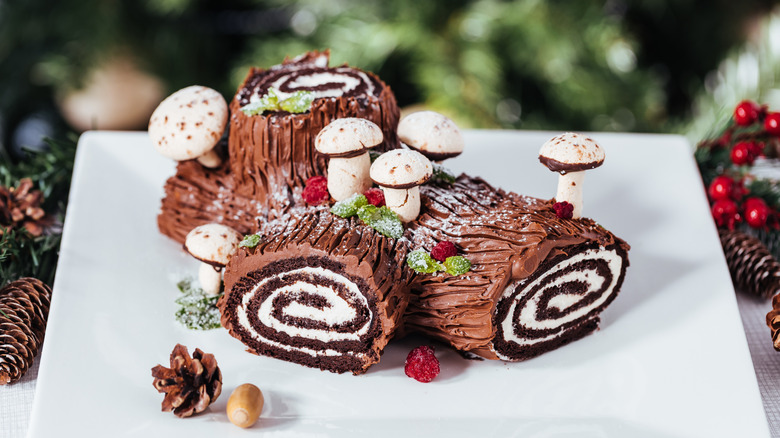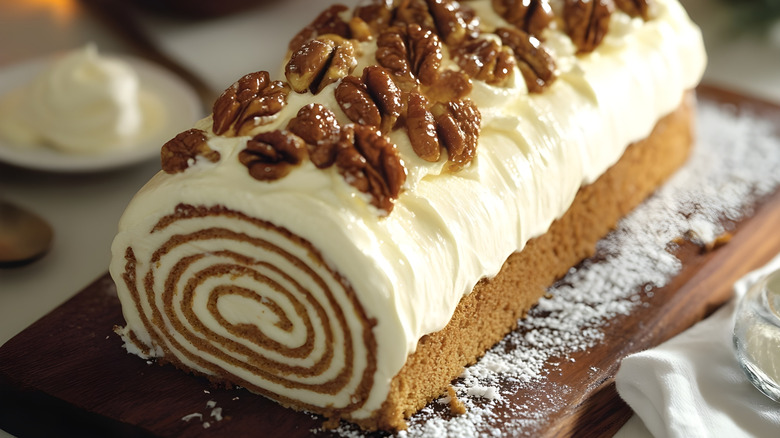Chefs Reveal Mistakes Everyone Makes With Yule Logs
If you aimed for a perfect Instagram-worthy Yule log and the results were more like something straight out of "Nailed It!," you're not alone. This holiday dessert makes an impressive centerpiece but it isn't easy to pull off. Most first-timers make all kinds of mistakes with Yule logs that can lead to cracks or total collapse.
As a recipe developer with experience running a small home bakery, I've made my fair share of these festive faves. However, I also spoke to two experts: Kelly Jacques, co-owner and chef of Ayu Bakehouse in New Orleans, and iconic pastry chef and TV personality Adriano Zumbo of "Zumbo's Just Desserts" and "Sugar Rush."
A Yule log, or bûche de Noël as it's known in France, is never going to be an easy dessert to make. If you're new to baking, it might not be the best place to start. But once you know some of the common ways people go wrong with Yule logs, it's easier to avoid these mistakes and turn out something worthy of a festive feast.
And, if it seems unmanageable, you can split the work up over several days, Jacques tells us. You can freeze the filled roulade and prep the decorations a few days ahead of time. "When you're ready to decorate, just pull your roulade out of the freezer, cut it to size, cover it with ganache, and add your decoration," she says.
Choosing a sponge recipe that isn't designed for rolling
If you have a favorite cake recipe, you might think you can just bake it in a jelly roll pan and you have the sponge for your Yule log sorted. But it's not this simple. This dessert needs to have a sponge that's suitable for rolling. Regular sponge cakes are likely to crumble or crack if you try to roll them.
"It really comes down to having the right recipe that's meant to be rolled, which usually entails separating, whipping, and folding eggs," says Kelly Jacques, whose bakery Ayu Bakehouse sells bûche de Noël over the festive season. If the sponge you want to make doesn't call for egg whites (or aquafaba as a vegan alternative) being whipped into peaks and folded into the batter, it's probably not going to be a great option for rolling. Ideally, follow a Yule log recipe, then you'll know the sponge works for this purpose.
Pastry chef Adriano Zumbo tells us that using a sugar that retains moisture can also help with making a sponge that's easy to roll without cracking. He recommends recipes that call for honey, corn syrup, or invert sugar (sugar as golden syrup).
Over-whipping or under-whipping your eggs
As we covered above, using whipped egg whites is a big part of what gives the sponge portion of a Yule log its proper texture. They help give it a flexible texture so you can roll it without cracking. However, you have to whip the eggs just right. Whipping them too much or too little are both issues to avoid.
Adriano Zumbo warns us against the perils of over-whipping egg whites for a bûche de Noël. What happens when you overmix egg whites is that the proteins in them break down and collapse. This means that the whites go flat and you lose all the air that you went to the trouble of whipping in there. They can also get an unpleasantly grainy texture.
Under-whipping your egg whites isn't good, either. For most recipes, you need to get the egg whites to stiff or soft peaks. When they reach this stage, they hold plenty of air in them, which they retain when you gently fold them into the dry ingredients. This is a big part of what gives the sponge its structure.
Whether you under- or over-whip your egg whites, the results are the same. The sponge will be dense rather than light and prone to cracking when you try to roll it.
Not spreading the batter evenly in the pan
Because it contains whipped egg whites, the batter for a Yule log is generally fairly thick and spreadable rather than thin and pourable. If you're used to thinner batters, you might expect the cake to level itself out in the pan. However, that's not the way with this mixture. It's up to you to spread the batter evenly in the pan.
According to Kelly Jacques, this is one of the ways to avoid your sponge cracking when you roll it. If it has some thick parts and some thin parts, it will be left with weak spots. As you roll it, the weaker parts of the cake won't be able to stand the pressure and will crack. It can also lead to an untidy-looking roll. Failing to spread the batter evenly is a common mistake in the world of Yule logs, but one that's easy to avoid when you know what to look out for.
Overbaking your sponge
It's a common mistake for people to overbake their sponges when making a bûche de Noël. Cooking your sponge until it's set but being careful not to bake it too long is the key here. If it's too well-baked, it will dry out and this can cause it to crack when you roll it.
"Perfecting your baking time and temperature is essential to getting the perfect texture for rolling," says Adriano Zumbo, who warns that overbaking is a problem you need to avoid. "Baking at a moderate temperature for 10 to 15 minutes is a rough guide," he notes. However, you should follow the time and temperature recommendations of the specific recipe you follow.
When it gets close to being baked, check it regularly. As soon as a toothpick comes out clean after inserting it into the sponge, it's ready to take out of the oven. Since the cake part of a Yule log is so thin, it's extremely easy to overbake it. In just a minute or two it can go from perfectly baked to dry and crumbly.
Not rolling the sponge in parchment paper while it's still warm
The secret to making a great Yule log is a simple one. When the sponge is still warm, you need to roll it up in parchment paper. This can go a long way to achieving a crack-free roulade. You can absolutely fill cracks with frosting and the cake will taste great anyway, but if you want that picture perfect spiral, this is a handy trick.
"Bake it until it's just set and then roll it up between parchment paper as soon as it's cool enough to handle," says Kelly Jacques. "This helps give the cake a little muscle memory to roll back up once filled." This is probably a technique you've noticed if you pay close attention to "The Great British Baking Show" and it's one that I've used to great success, too.
However, not everyone believes this step is essential. Adriano Zumbo suggests covering the sponge with a tea towel as soon as you get it out of the oven to help it retain moisture and make it easier to roll.
Using too much or too little filling
A Yule log consists of a sponge wrapped around a filling, such as buttercream or whipped cream, and then coated in a thick ganache. But getting the amount of filling right can be an issue. People commonly either use too much or too little, neither of which is ideal.
Kelly Jacques agrees that the quantity of filling you use is important. "Don't skimp on it," she says. Using plenty of it helps make sure the flavor comes through against the rich chocolate of the sponge — and let's not forget aesthetics. "I aim for equal thicknesses of cake and filling to get that clear spiral effect."
Using a good amount of filling like this looks great but if you overdo it, you can make your log difficult to roll. The filling can end up spilling out. Plus, if it's a sweet filling, too much can make the finished dessert overly rich. That's why Adriano Zumbo believes that using too much filling is just as big a problem as using too little. You need to find the balance so your dessert looks great, tastes great, and is manageable to assemble.
Making the filling too runny or too thick
It's a rookie error making the filling for your Yule log either too runny or too thick. But, it's one that a lot of people fall for so don't be disheartened if it's happened to you. Finding the perfect consistency for your filling means the whole dessert will come together more easily.
"Your filling should be a thick, spreadable consistency," Kelly Jacques tells us. You need it to hold up well but be easy to spread onto your sponge. If it's too thick it won't be spreadable and you'll end up tearing your sponge when you try to layer the filling on it.
Adriano Zumbo also talks about filling consistency, saying many people make theirs too thin or too thick. He recommends using a tried and tested recipe, so you know it will work as a Yule log filling. He also notes that any filling should have a "stable but unctuous texture that holds," adding that "a good test is to run your finger or a tip of [a] spoon through and it should be soft but hold itself." If you achieve this texture, you can expect your filling to be perfect.
Filling your sponge while it's still warm
One of the most frequent mistakes people make with Yule logs is filling them while the sponge is still warm. We get that it's a long, fairly involved recipe and you probably want to get it done. But the simple act of filling an even slightly warm sponge can make all your hard work go to waste.
"Make sure the cake is completely cool before filling," advises Kelly Jacques. "Otherwise, your filling will melt right out, even if the cake is just slightly warm." The heat of the sponge melts the filling, whether it's buttercream, whipped cream, or anything else you choose to use. So, when you try to roll it up, the filling has lost its perfect consistency that holds its shape and just spills out.
At the same time, it will soak into the sponge which may make it disintegrate the next time you try to roll it. So, it's not like you can just scrape out the filling and start again. Save yourself the heartache and wait until your sponge is properly cool before attempting to fill and roll it.
Rolling it the wrong way
In search of that perfect spiral, you might assume that you should roll your sponge from the shortest side, but that's not going to get you an elegant Yule log. It's a common mistake, though, and one that's so easy to avoid. When rolling your sponge with its filling, you should do so from the longer side.
If you chose to roll your sponge with baking parchment to prevent cracks, unroll it before filling. Keep the long side that was in the center of the roll closest to you. And lay it on a sheet of parchment paper. As mentioned above, you need to make sure it's completely cool before you proceed.
Next, spread a layer of your filling over the entire top of the sponge, making sure to go all the way to the edges. Roll the sponge from the side closest to you, keeping the roll as tight as possible without squeezing out the filling. Use the baking parchment as you roll, pressing on that instead of the delicate cake. When it's all rolled up, arrange it seam-side down.
It's important to roll it the correct way around. If you roll it from the short side, you'll get too large a spiral and it will end up short and thick. It will be more like a stump than a log and the effect just won't be the same.
Sticking to a buttercream filling
A Yule log is one of those iconic Christmas desserts you need to try at least once. However, you don't have to stick to all the rules. These roulades usually have buttercream or simple whipped cream inside the roll but you can explore beyond that. If you only ever use the expected filling, you won't make an exceptional Yule log, just a perfectly good one.
Aside from buttercream, Adriano Zumbo suggests Chantilly cream (sweetened whipped cream with vanilla), jam, curd, whipped ganache, or crémeux (a kind of chocolate custard). If you like buttercream but want to elevate it, you could also try Swiss meringue or Italian meringue buttercream. These are both lighter in texture and slightly less sweet than American buttercream.
You don't have to stick to just one filling, either. For instance, you could pair Chantilly cream with a jam or curd. As long as the consistency is correct — not too thin or too thick — you can use any filling that appeals to you.
Making the ganache for the exterior the wrong consistency
One of the final steps to making your Yule log is covering it in ganache. It's part of what makes it look like a log rather than just a jelly roll. It might seem like one of the easy parts but the texture of the ganache is important. It needs to be spreadable but thick enough to hold up on the exterior. You're not looking for a pourable ganache here. However, if it's too thick it could tear the cake as you attempt to frost it.
Both Adriano Zumbo and Kelly Jacques say that recipes that contain butter and invert sugar syrup make a particularly supple, smooth ganache that's perfect for the outside of a Yule log. These ingredients help it get to the consistency where you can easily spread it on your log and it holds up to decoration.
When you prepare it and how you store it can make a difference too. "I like to prep my ganache the day before and let it sit at room temperature for the perfect spreadable consistency," says Jacques. If you make it in advance, storing it in the fridge is a bad idea, as this will harden it and make it tough to spread.
Not attempting the bark texture on the outside
How you transform this festive dessert from a big brown lump into an elegant Yule log is all about decoration. It's not enough to cover it in ganache, you also have to make the bark texture on it. Some people skip this step because they think it will be too challenging and end up looking bad. But, it's really not as difficult as you think. In my experience, even a haphazard attempt looks better than no attempt at all.
All you need to pull this off is something sharp and pointy. I use a metal skewer, but you could also use a corn on the cob holder or even just a sharp knife. Some people also use a fork, though the four tines so close together makes it look a little too regular for my preference. Use your utensil of choice to make slightly wavy or jagged lines with a bark-like texture. Look at some photos of bark if you need inspiration. And, don't worry too much, because once you dust over some powdered sugar snow, it will hide a multitude of sins. Some people also just use shards of chocolate to make bark, which is a good alternative.
Failing to dry out meringue decorations correctly
Meringue mushrooms are a classic bûche de Noël decoration. Now, you absolutely don't have to go this far with decorating your dessert. It will look perfectly lovely with textured bark and some "snow." But if you choose the meringue route, you need to dry out those decorations correctly.
"We're in New Orleans, where the humidity can be high year-round, wreaking havoc on meringue decor if we don't dry them out super thoroughly in a dehydrator," says Kelly Jacques. Most people don't have dehydrators at home, but cooking meringue decorations low and slow in an oven has the same effect. You can dry them out even further by cracking the oven door when they're done baking and leaving them in there with the door ajar to cool.
If you make your meringue mushrooms ahead of time, keep them in an airtight container until you're ready to use them. Any excess moisture can cause them to go soggy and collapse.
Only making a classic chocolate Yule log
A Yule log might be one of the festive ways to use chocolate during the holiday season, but you don't always have to stick to tradition. Usually, this dessert features a chocolate sponge and chocolate ganache on the outside. The filling may or may not feature chocolate. However, it doesn't have to be this way. If you're not experimenting with other flavors, you're missing out.
"Satsuma Pecan has been our go-to flavor for our Bayoule Log," Kelly Jacques tells us. "Not only does it celebrate local flavors, but the tartness of the satsuma curd helps to cut through the richness of the pecan praline and chocolate for a more balanced flavor profile." Adriano Zumbo also had a range of suggestions for us beyond chocolate, including coconut and passionfruit, red velvet, black sesame, and hazelnut praline.
You can stick with a chocolate exterior if you want the classic log look but switch out the chocolate sponge for something different. However, it's fine to have a different colored exterior. If it's white or off-white, it could be a silver birch or a log on a snowy day.
